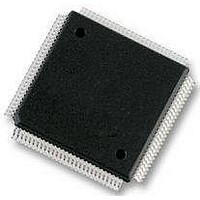MC9S12E128CPV Freescale Semiconductor, MC9S12E128CPV Datasheet - Page 200

MC9S12E128CPV
Manufacturer Part Number
MC9S12E128CPV
Description
Microcontrollers (MCU) 16 Bit 16MHz
Manufacturer
Freescale Semiconductor
Datasheet
1.MC9S12E128CPV.pdf
(606 pages)
Specifications of MC9S12E128CPV
Data Bus Width
16 bit
Program Memory Type
Flash
Program Memory Size
128 KB
Data Ram Size
8 KB
Interface Type
SCI, SPI
Maximum Clock Frequency
25 MHz
Number Of Programmable I/os
92
Number Of Timers
16 bit
Operating Supply Voltage
3.135 V to 5.5 V
Maximum Operating Temperature
+ 85 C
Mounting Style
SMD/SMT
Package / Case
LQFP-112
Minimum Operating Temperature
- 40 C
On-chip Adc
10 bit
On-chip Dac
8 bit, 2 Channel
Lead Free Status / Rohs Status
No RoHS Version Available
Available stocks
Company
Part Number
Manufacturer
Quantity
Price
Company:
Part Number:
MC9S12E128CPVE
Manufacturer:
Freescale Semiconductor
Quantity:
10 000
- Current page: 200 of 606
- Download datasheet (4Mb)
Chapter 4 Clocks and Reset Generator (CRGV4)
4.6
The interrupts/reset vectors requested by the CRG are listed in
chapter for related vector addresses and priorities.
4.6.1
The CRGV4 generates a real-time interrupt when the selected interrupt time period elapses. RTI interrupts
are locally disabled by setting the RTIE bit to 0. The real-time interrupt flag (RTIF) is set to 1 when a
timeout occurs, and is cleared to 0 by writing a 1 to the RTIF bit.
The RTI continues to run during pseudo-stop mode if the PRE bit is set to 1. This feature can be used for
periodic wakeup from pseudo-stop if the RTI interrupt is enabled.
4.6.2
The CRGV4 generates a PLL lock interrupt when the LOCK condition of the PLL has changed, either
from a locked state to an unlocked state or vice versa. Lock interrupts are locally disabled by setting the
LOCKIE bit to 0. The PLL Lock interrupt flag (LOCKIF) is set to1 when the LOCK condition has
changed, and is cleared to 0 by writing a 1 to the LOCKIF bit.
4.6.3
The CRGV4 generates a self-clock mode interrupt when the SCM condition of the system has changed,
either entered or exited self-clock mode. SCM conditions can only change if the self-clock mode enable
bit (SCME) is set to 1. SCM conditions are caused by a failing clock quality check after power-on reset
(POR) or low voltage reset (LVR) or recovery from full stop mode (PSTP = 0) or clock monitor failure.
For details on the clock quality check refer to
is enabled (CME = 1) a loss of external clock will also cause a SCM condition (SCME = 1).
SCM interrupts are locally disabled by setting the SCMIE bit to 0. The SCM interrupt flag (SCMIF) is set
to 1 when the SCM condition has changed, and is cleared to 0 by writing a 1 to the SCMIF bit.
200
Interrupts
Real-Time Interrupt
PLL Lock Interrupt
Self-Clock Mode Interrupt
Real-time interrupt
Interrupt Source
LOCK interrupt
SCM interrupt
Table 4-15. CRG Interrupt Vectors
MC9S12E128 Data Sheet, Rev. 1.07
Section 4.4.4, “Clock Quality
Mask
CCR
I bit
I bit
I bit
CRGINT (LOCKIE)
CRGINT (SCMIE)
CRGINT (RTIE)
Local Enable
Table
4-15. Refer to the device overview
Checker.” If the clock monitor
Freescale Semiconductor
Related parts for MC9S12E128CPV
Image
Part Number
Description
Manufacturer
Datasheet
Request
R
Part Number:
Description:
Manufacturer:
Freescale Semiconductor, Inc
Datasheet:
Part Number:
Description:
Manufacturer:
Freescale Semiconductor, Inc
Datasheet:
Part Number:
Description:
Manufacturer:
Freescale Semiconductor, Inc
Datasheet:
Part Number:
Description:
Manufacturer:
Freescale Semiconductor, Inc
Datasheet:
Part Number:
Description:
Manufacturer:
Freescale Semiconductor, Inc
Datasheet:
Part Number:
Description:
Manufacturer:
Freescale Semiconductor, Inc
Datasheet:
Part Number:
Description:
Manufacturer:
Freescale Semiconductor, Inc
Datasheet:
Part Number:
Description:
Manufacturer:
Freescale Semiconductor, Inc
Datasheet:
Part Number:
Description:
Manufacturer:
Freescale Semiconductor, Inc
Datasheet:
Part Number:
Description:
Manufacturer:
Freescale Semiconductor, Inc
Datasheet:
Part Number:
Description:
Manufacturer:
Freescale Semiconductor, Inc
Datasheet:
Part Number:
Description:
Manufacturer:
Freescale Semiconductor, Inc
Datasheet:
Part Number:
Description:
Manufacturer:
Freescale Semiconductor, Inc
Datasheet:
Part Number:
Description:
Manufacturer:
Freescale Semiconductor, Inc
Datasheet:
Part Number:
Description:
Manufacturer:
Freescale Semiconductor, Inc
Datasheet:











